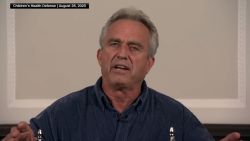The high-stakes presidential election has taken on increased significance for Democrats’ precarious path to holding power in the Senate.
Why? Because of the map. Democratic Sen. Joe Manchin’s decision not to run for reelection in West Virginia underscored how advantageous the 2024 playing field is for Republicans. But President Joe Biden winning reelection would give Senate Democrats a slight – emphasis on slight – cushion because of the tie-breaking role of the vice president in an evenly divided chamber.
The GOP needs to pick up only one or two seats – depending on which party wins the White House – to flip control of the Senate. West Virginia has long ranked as the seat most likely to flip, and with Manchin’s departure, Republicans are now almost certain to pick it up.
Attention has shifted to the two other red-state seats that Democrats are defending – Montana and Ohio, which are the second and third most likely to flip, respectively. (Rankings are based on CNN’s reporting, fundraising figures and historical data about how states and candidates have performed.)
The race for Senate control this year will offer a crucial political test: Are races so nationalized that the top of the ticket – and the factors swaying the contest – is all that matters? (That’s especially important this year because of how much overlap there is between five states that hold key Senate races and the presidential battlegrounds.) Or are individual candidates, the races they run and local issues just as important? The answer will likely decide who wins the chamber.
Democrats are defending seven of the top 10 Senate seats most likely to flip. An eighth, Arizona, is held by a onetime Democrat, independent Sen. Kyrsten Sinema, who still caucuses with her former party and hasn’t said whether she’s running for reelection. Manchin’s decision has had the immediate effect of making the only two Democratic targets on this list – Texas and Florida – much more prominent in the party’s 2024 strategy.
Assuming West Virginia is off the map for Democrats, here’s what may need to happen for them to keep control of the Senate: They could defend all of their remaining seats and retain the presidency (because of the vice president’s tie-breaking vote in a 50-50 Senate); they could hold all their remaining seats, lose the presidency, but flip either Florida or Texas; or they could lose another seat, win the presidency and flip both Florida and Texas. Flipping either of those states while losing the presidency would mean the Democratic Senate candidate would have to significantly overperform the top of the ticket.
The math is daunting. Especially when multiple national and swing-state polls show Biden trailing his predecessor and the current GOP front-runner Donald Trump in a hypothetical rematch.
The Democratic senators on whom control of the chamber rests – specifically Jon Tester of Montana and Sherrod Brown of Ohio – likely need to distance themselves from the presidential race as much as possible. Both are well-established incumbents with individual brands back home, but it remains to be seen whether that’ll be enough for them to buck their states’ partisan lean as they have done in the past.
Democrats make the same argument – about the saliency of personality over partisanship – to explain how they can defeat Sens. Rick Scott in Florida and Ted Cruz in Texas. But those are expensive states that have eluded Democrats for years, and investing there could divert resources from seats they’re defending.
If there’s a glimmer of hope for Democrats, it’s that GOP primaries are bubbling, despite the National Republican Senatorial Committee’s new strategy of throwing its support early behind a candidate it identifies as the stronger general election nominee. Such a contested primary matters less in West Virginia. But a divisive GOP race is a real possibility in Montana, and there are crowded fields in Ohio, Nevada and Michigan. In Wisconsin, the GOP missed on its first-choice recruit and is waiting on a wealthy businessman to get into the race. The Republican front-runner for the Senate seat in Arizona is an ardent election denier. Only in Pennsylvania has the GOP avoided an internecine battle, allowing its candidate to already go toe-to-toe with the Democratic incumbent. But it remains to be seen whether the GOP’s strategy of recruiting wealthy candidates – some of whom haven’t faced much scrutiny until now – pays off.
As the election year begins, there are several key things to watch. Fundraising reports from the final quarter of 2023 will come out later this month. Can Democrats sustain their fundraising momentum? Do wealthy GOP recruits self-fund in a meaningful way? Do Republicans land a candidate in Wisconsin and settle their primaries with minimal damage to their ultimate nominees?
These rankings will be updated over the course of the year as we get more of those data points.
For now, here are the 10 Senate seats most likely to flip:
1. West Virginia

Democratic Sen. Joe Manchin’s decision not to run for reelection sank whatever chance his party still had of holding this seat in a state Trump twice carried by about 40 points.
Republicans are well-positioned to pick up the seat with either Gov. Jim Justice or US Rep. Alex Mooney as their nominee. Mooney and his allies at Club for Growth Action, which has promised to spend millions boosting the congressman, are trying to tie Justice, a former Democrat, to Biden and his party.
A group called Conservative Americans PAC is hitting back at Mooney, highlighting his Maryland roots and pointing out that the club has also opposed Trump. Justice has the backing of both the National Republican Senatorial Committee and Trump, whose endorsement carries significant weight in this deep-red state.
2. Montana
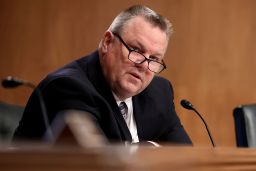
Democratic Sen. Jon Tester’s reelection bid will be the biggest barometer of whether incumbents with strong brands can still buck the partisanship of their states – a test he’s passed three times before.
Republicans are enthused about their recruit to take on Tester. Retired Navy SEAL Tim Sheehy has been quick to get on the air and introduce himself to voters, which his campaign credits with boosting the political newcomer’s standing in a hypothetical primary against US Rep. Matt Rosendale. A recent ad leans into Sheehy’s military service while attacking Tester (and Biden) for being “too liberal to keep us safe.” Sheehy also has a supportive super PAC in his corner.
But the Minnesota native has faced a few negative headlines – which Democrats have pounced on – including a Semafor story about comments he made in August about wanting to return health care to “pure privatization.” (His spokesperson has said he was attacking insurance companies and supports protections for pre-existing conditions, as well as honoring Medicare and Social Security commitments.)
This race also offers the best test case for national Republicans’ new strategy of taking sides early in a primary. Rosendale, who lost to Tester in 2018, is the kind of nominee the NRSC is trying to avoid this cycle. But the House Freedom Caucus member is increasingly making noise about getting in ahead of the March 11 filing deadline.
After the NRSC marked former House Speaker Kevin McCarthy’s retirement announcement with a statement attacking Rosendale (one of eight Republicans who voted to oust the Californian as speaker in October), the congressman recorded a video message in which he said he was “heavily considering” running for Senate. Two days later, he posted on X photos of him running into Trump at Mar-a-Lago to promote a potential Senate bid – which, as CNN has reported, frustrated the former president since the congressman hadn’t yet endorsed him at the time. (Rosendale did so shortly afterward, but that was months after Sheehy had declared his support for Trump.)
One thing that could help Rosendale? A super PAC called Last Best Place, which hasn’t yet had to disclose its donors, has been attacking Sheehy on air. Republicans have accused it of being a Democratic front group. Senate Majority PAC — the Democratic super PAC tied to leadership — has declined to comment when asked whether it is involved.
Democrats insist Tester can win against either Republican. For the senator’s part, he’s on the air with positive bio ads, reminding voters of his farming background and his commitment to public lands, Second Amendment rights and defending Montanans’ way of life. Another ad touts his work on the PACT Act, which expands health care benefits for veterans exposed to toxic burn pits.
3. Ohio

Sen. Sherrod Brown is the other Democrat facing reelection in a state Trump carried twice, and therefore one of the GOP’s top targets. But until the March 19 primary, the three-term incumbent gets to watch his would-be Republican opponents fight among themselves while he paints each of them as too extreme.
The day after Ohioans overwhelmingly approved a ballot measure guaranteeing the right to abortion in November, Brown’s team released a video compilation of quotes by his Republican challengers that suggested they would back a national abortion ban.
The national GOP isn’t taking sides in this race, but Trump waded in toward the end of last year, backing wealthy businessman Bernie Moreno. Moreno also has the support of the state’s other US senator, J.D. Vance, who received a boost from Trump in his own GOP primary in 2022. A recent ad by Moreno opens and closes with the former president praising the GOP hopeful, who goes on to say, “The first thing we have to do is we have to finish the wall.”
State Sen. Matt Dolan, the more moderate candidate in the race, also opens his advertising focused on border security, but without any explicit Trump-like appeal. Both candidates have significant personal wealth – they each loaned their campaigns $3 million in the third quarter.
Ohio Secretary of State Frank LaRose, the only statewide elected official in the race, started the campaign in a more prominent position. But his rivals have been keen to call into question his ability to deliver for conservatives after the failure of an August ballot measure that was seen as a proxy fight for the November referendum on abortion rights.
4. Pennsylvania
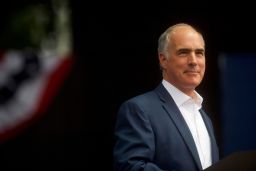
Pennsylvania is the rare Republican-targeted seat that doesn’t have a complicated GOP primary – which explains why it sits relatively high on this list. Because the GOP landed former hedge fund executive Dave McCormick and avoided a challenge from failed 2022 gubernatorial nominee Doug Mastriano, the party was able to launch its fight against Democratic Sen. Bob Casey well before the election year began. This will likely be Casey’s toughest Senate race yet as he seeks a fourth term.
China has already emerged as a central motif in this race. McCormick, an Army veteran, has proposed “six bans” to end “China’s free ride.” But as CNN’s KFile reported, his strong anti-China positioning now appears to be an evolution from his time at Bridgewater Associates, where he oversaw massive investments into US exchange-traded Chinese companies and holdings. Casey recently introduced legislation (with GOP Sen. Rick Scott of Florida, who’s also up for reelection) that he says would require private investment funds to disclose assets invested in China.
Casey, who has the AFL-CIO’s endorsement, is trying to highlight a populist identity, with Democrats using McCormick’s hedge fund background to cast him as out of touch. More recently, both candidates have come out against the sale of US Steel to a Japanese company. But with Biden struggling in the polls in Pennsylvania, which he narrowly won in 2020, and with voters concerned about the economy, the choice may not be as clear-cut as Democrats would like it to be.
5. Arizona
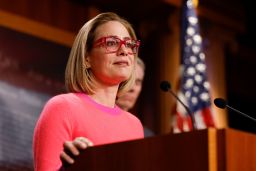
Independent Sen. Kyrsten Sinema is keeping everyone guessing about her reelection plans and whether this will be a three-way race. She’ll have to file as a candidate with the secretary of state’s office by April 8.
If she does run, Republicans are hoping she’ll take more votes away from the Democrat, rather than from their eventual nominee. That much is apparent in an NRSC digital ad that attacks Democratic Rep. Ruben Gallego, including in personal terms, and makes Sinema – who’s been a thorn in the side of Senate Democratic leadership – sound like a liberal.
Kari Lake, fresh off her 2022 gubernatorial loss, is the front-runner for the GOP nomination. Despite national Republicans’ pleas for her to look forward – and the backing of more establishment party voices such as Wyoming Sen. John Barrasso, a member of Senate GOP leadership – Lake is still contesting her previous defeat. She lost another legal case in November over a request to examine ballot envelopes from 2022.
But with Trump’s endorsement and her appeal to base GOP voters, Lake will be hard to beat in the August primary, and the national party hasn’t ruled out getting behind her. Running against Lake is an exciting prospect for Democrats, but the national party is waiting to see how things shake out with Sinema before getting involved.
6. Nevada

Nevada presents another pickup opportunity for Republicans, who would like to unseat Democratic Sen. Jacky Rosen after coming up short against Sen. Catherine Cortez Masto in 2022, when they successfully flipped the governor’s office.
There’s a crowded field of Republicans running in the June primary, but the national party is behind retired Army Capt. Sam Brown, who finished second in last year’s Senate primary.
Nevada backed Biden by about 2 points in 2020, and Democrats are hopeful that their ground game here during a presidential year – combined with the salience of the abortion issue – will help their whole ticket. But early polling of a hypothetical matchup between Biden and Trump raised some alarm bells for Democrats, with the former president leading the current president 52% to 41% among registered voters in a New York Times/Siena College poll conducted in late October. Hispanic voters were split evenly, as were White college-educated voters – usually a key group for Democrats.
Republicans know that recent federal election results haven’t been in their favor here, but they see an opportunity to make inroads with Hispanic voters. And even if they cannot win this seat, forcing Democrats to spend money here that won’t be going to Montana or Ohio could be its own victory.
7. Wisconsin
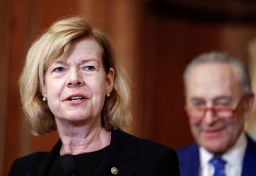
Republicans don’t yet have a major candidate to take on Democratic Sen. Tammy Baldwin after their top choice – US Rep. Mike Gallagher – passed on the race. But since then, all eyes have long been on businessman Eric Hovde, whom NRSC Chairman Steve Daines has said is running. Hovde, who lost the GOP nomination for this seat in 2012, has the ability to self-fund – an attractive option for Republicans, especially since it’s relatively late in the cycle for a challenger to enter.
There’s still a question of whether another wealthy Republican businessman, Scott Mayer, would get into the race, but Daines has made it clear he doesn’t want a primary here. “If Eric gets into the race,” he told The Washington Examiner, “we’d be behind Eric.” The NRSC’s early support for Hovde has also angered David Clarke, the Trump-aligned former Milwaukee County sheriff, who could complicate the GOP’s path here if he enters the race.
Democrats cannot take too much comfort in the absence of a major GOP candidate so far. Despite Biden narrowly winning the state in 2020, Democrats could not unseat GOP Sen. Ron Johnson last cycle. And a November Marquette poll found Biden in a close race with Trump among registered Wisconsin voters.
8. Michigan

Michigan Democrats have largely coalesced around US Rep. Elissa Slotkin – a powerhouse fundraiser – in the race to succeed retiring Democratic Sen. Debbie Stabenow.
Republicans, however, have an ever-growing primary in a state where they haven’t won a Senate race since 1994. National Republicans have embraced the return of former US Rep. Mike Rogers, who left Congress in 2015. But the former House Intelligence Committee chairman has hardly cleared the field. Former US Rep. Peter Meijer – who lost a primary over his vote to impeach Trump after the January 6, 2021, insurrection – announced his campaign in early November. His vote against Trump carries liabilities in a primary, which the NRSC has openly highlighted in its attempts to get him not to run.
Other Republicans who launched campaigns after Rogers entered the race include former Detroit Police Chief James Craig, who was disqualified from the 2022 governor’s race over signature gathering issues, and businessman Sandy Pensler, who lost the GOP nod for the seat in 2018.
Democrats did well In Michigan in 2022, and the state GOP is in disarray. But Biden doesn’t look as strong here as he did in 2020, when he won the state by about 3 points. In recent CNN polling of the Wolverine State, for example, Trump led Biden 50% to 40% among registered voters, with even young voters breaking in Trump’s favor. Slotkin’s campaign manager pushed back on New York Times reporting from December that the congresswoman was concerned about being on the ticket with Biden, saying she “looks forward” to running with the president.
9. Texas

Texas – along with Florida – has taken on even more importance for national Democrats as a rare chance to flip a Senate seat and mitigate the likely Republican pickup in West Virginia. The Democratic Senatorial Campaign Committee has invested in communications and research staff in both states and run digital ads against the GOP incumbents.
Democratic Rep. Colin Allred faces a primary on March 5, but his strong fundraising and profile as a former NFL player have made him the man to beat for the nomination. Allred has won tough races before, having unseated a Republican incumbent to first win election to Congress. And his campaign is arguing that, like in that 2018 House race, health care will be a key issue in this year’s Senate contest. Besides touting his support for the Affordable Care Act, Allred has been speaking out about the case of Kate Cox – the Texas woman who battled the state to terminate her high-risk pregnancy – to try to create a contrast with Cruz on abortion rights.
Cruz, who won his last race by less than 3 points, makes an attractive boogeyman for the left. But the massive small-dollar donations he inspires from his detractors don’t necessarily translate to defeat for the incumbent. Even well-funded Democrats (see Beto O’Rourke) have fallen short in Texas, which hasn’t elected a Democrat statewide since 1994. So despite the contest’s higher prominence for national Democrats, it’s still Cruz’s race to lose.
10. Florida
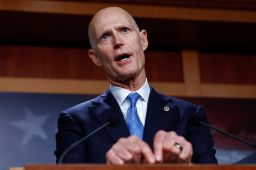
It’s a similar story in Florida, where national Democrats have made investments in hopes of unseating Republican Sen. Rick Scott. But it’s an uphill fight in the red-trending state. Just ask Democratic former Rep. Val Demings – a high-profile recruit who lost to Sen. Marco Rubio in 2022 by 16 points. Add to that, Scott will have his vast personal fortune to draw from as he bids for a second term.
But Democrats sense a potential opportunity given that Scott, a former two-term governor, has never won any of his races by more than about a point – and this will be his first time running in a presidential year. He was also the author of a policy plan that proposed a sunset provision for all federal programs, which was so unpopular even fellow Senate Republicans had to disavow it. (He later revised it to exempt Social Security and Medicare from the provision.) Expect Democrats to give that plenty of airtime in the retiree-heavy state.
Former US Rep. Debbie Mucarsel-Powell has generated most of the attention on the Democratic side ahead of the August primary. She’s shown early fundraising prowess – narrowly outraising the incumbent, excluding his personal contribution, during the first partial quarter she was in the race – but her end-of-the-year fundraising haul will be closely scrutinized to see how sustainable that momentum will be.

















